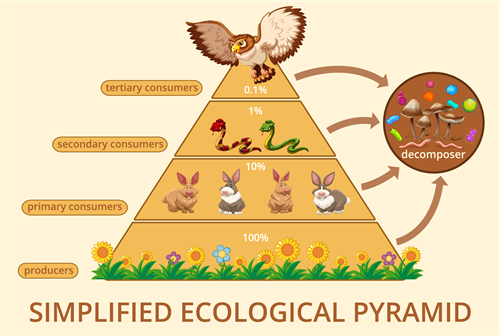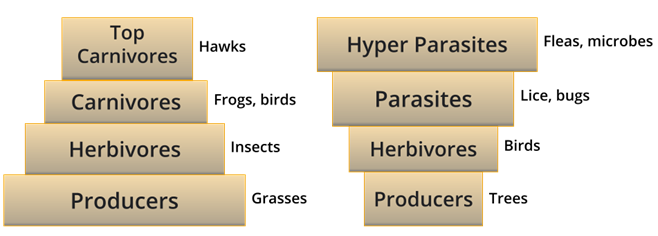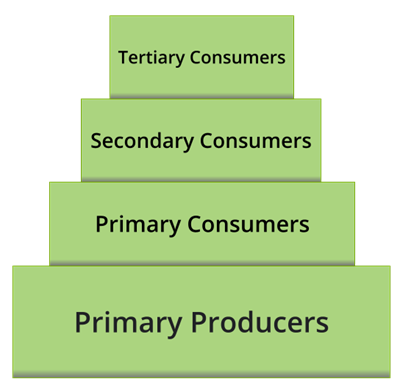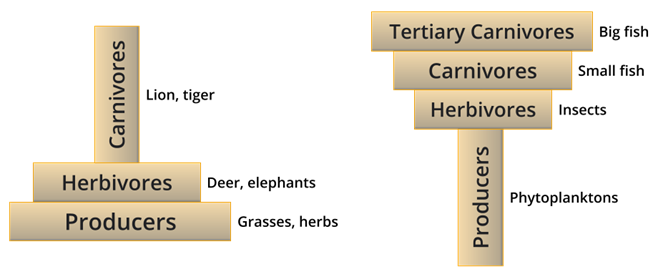
PUMPA - SMART LEARNING
எங்கள் ஆசிரியர்களுடன் 1-ஆன்-1 ஆலோசனை நேரத்தைப் பெறுங்கள். டாப்பர் ஆவதற்கு நாங்கள் பயிற்சி அளிப்போம்
Book Free Demo
Charles Elton proposed the concept of ecological pyramids in \(1927\). They are also known as "Eltonian pyramids".  In grassland, pond ecosystems, the pyramid is erect as species decrease from producer to apex carnivore. In some food chains, an inverted pyramid can be observed when a single producer, for example, a tree, supports a huge number of herbivorous birds, which supports a bigger number of parasites, which in turn supports an even larger number of hyper parasites.
In grassland, pond ecosystems, the pyramid is erect as species decrease from producer to apex carnivore. In some food chains, an inverted pyramid can be observed when a single producer, for example, a tree, supports a huge number of herbivorous birds, which supports a bigger number of parasites, which in turn supports an even larger number of hyper parasites.  The energy content is expressed in terms of \(kcal/m^2/yr\) or \(KJ/m^2/yr\). The maximum energy is present in the producers. The energy pyramid is always upright as \(80\ -\ 90 \%\) of the energy available at the lower trophic level is used to overcome entropy and to perform various metabolic activities at each transfer. The next trophic level has access to only \(10 \%\) of the energy.
The energy content is expressed in terms of \(kcal/m^2/yr\) or \(KJ/m^2/yr\). The maximum energy is present in the producers. The energy pyramid is always upright as \(80\ -\ 90 \%\) of the energy available at the lower trophic level is used to overcome entropy and to perform various metabolic activities at each transfer. The next trophic level has access to only \(10 \%\) of the energy. 
Ecological pyramids are a graphical representation of ecological parameters such as the biomass, energy or the number of individuals in various trophic levels of a food chain, with the producer at the bottom and the top carnivore at the tip.

The energy pyramid
Each of the trophic levels represents a functional level. In the pyramid, the various steps of a food chain are represented step-wise. A pyramid can be upright (tapering towards the point), inverted (narrow at the tip), or spindle-shaped (broad in the middle and narrow above and below).
Ecological pyramids are classified into three categories based on the factors used:
1. Pyramid of numbers
2. Pyramid of biomass
3. Pyramid of energy
1. Pyramid of numbers:
It is a graphic representation of the number of individuals at various trophic levels of a food chain in an ecosystem.

Representation of pyramid of numbers in two different ecosystems: Left - Grassland; Right - Parasitic food chain
2. Pyramid of biomass:
The amount of living matter is called biomass. Biomass can be measured as dry weight and fresh weight.
It is a graphic representation of biomass present per unit area at various trophic levels (total amount of organic matter in an ecosystem at any one time).
The pyramid of biomass is more realistic than the pyramid of numbers. The maximum biomass is found in producers in a terrestrial ecosystem, and biomass decreases as trophic levels rise. As a result, the biomass pyramid in a terrestrial ecosystem is upright.
In an aquatic environment, the biomass pyramid is inverted or spindle-shaped, with trophic level biomass determined by its members' reproductive potential and longevity.
.

Representation of pyramid of biomass in forest and pond
3. Pyramid of energy:
It is a graphical representation of the amount of energy trapped per unit time and area in various food chain trophic levels, with producers at the bottom and carnivores at the tip.

Pyramid of energy
Limitations of the ecological pyramid:
1. Ecological pyramids assumes that the food chain is a simple one. Simple food chains do not occur in nature; instead, food webs are present.
2. A single species can be present and can operate in two or more trophic levels. Ecological pyramids do not accommodate such cases.
3. Ecological pyramids do not have a place for decomposers, even though they play a vital role in the ecosystem.
In the next theory, we will study about food web.